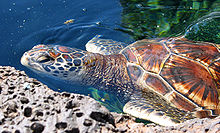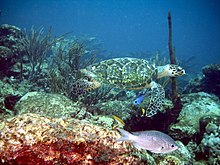This is an old revision of this page, as edited by 71.161.83.67 (talk) at 01:15, 9 November 2006 (→Physical description). The present address (URL) is a permanent link to this revision, which may differ significantly from the current revision.
Revision as of 01:15, 9 November 2006 by 71.161.83.67 (talk) (→Physical description)(diff) ← Previous revision | Latest revision (diff) | Newer revision → (diff) For other uses, see Turtle (disambiguation).
| Turtles Temporal range: Triassic - Recent | |
|---|---|

| |
| "Chelonia" from Ernst Haeckel's Kunstformen der Natur, 1904 | |
| Scientific classification | |
| Kingdom: | Animalia |
| Phylum: | Chordata |
| Class: | Sauropsida |
| Order: | Testudines Linnaeus, 1758 |
| Suborders | |
|
Cryptodira | |
Turtles are reptiles of the order Testudines (all living turtles belong to the crown group Chelonia), most of whose body is shielded by a special bony or cartilagenous shell developed from their ribs. The Order Testudines includes both extant (living) and extinct species, the earliest turtles being known from the early Triassic Period, making turtles one of the oldest reptile groups, and a much more ancient group than the lizards and snakes. About 300 species are alive today. Some species of turtles are highly endangered. Like birds, turtles are able to detect the Earth's magnetic field with magnetosensors, which allow them to migrate.
Evolution
The first turtles are believed to have existed in the Mesozoic, around 200 million years ago. Their exact ancestry is disputed. It was believed that they are the only surviving branch of the ancient clade Anapsida, which includes groups such as procolophonoids, millerettids, protorothyrids and pareiasaurs. All anapsid skulls lack a temporal opening, while all other extant amniotes have temporal openings (although in mammals the hole has become the zygomatic arch). Most anapsids became extinct in the late Permian period, except procolophonoids and possibly the precursors of the testudines (turtles).
However, it was recently suggested that the anapsid-like turtle skull may be due to reversion rather than to anapsid descent. More recent phylogenetic studies with this in mind placed turtles firmly within diapsids, slightly closer to Squamata than to Archosauria. All molecular studies have strongly upheld this new phylogeny, though some place turtles closer to Archosauria. Re-analysis of prior phylogenies suggests that they classified turtles as anapsids both because they assumed this classification (most of them studying what sort of anapsid turtles are) and because they did not sample fossil and extant taxa broadly enough for constructing the cladogram. Future analyses may show the turtles to be relatives of the placodonts.
A new phylogenetic analysis agrees with prior analyses nesting turtles with pareiasaurs within the much larger clade, Lepidosauromorpha. The closest pareiasaur to turtles appears to be a rarely-studied form, Stephanospondylus. Indeed turtles are related to other reptiles without temporal openings. They are also closer to lizards than they are to archosaurormophs, including placodonts.
The earliest known modern turtle is proganochelys, though this species already had many advanced turtle traits, and thus probably had many millions of years of preceding "turtle" evolution and species in its ancestry. It did lack the ability to pull its head into its shell (and it had a long neck), and had a long, spiked tail ending in a club, implying an ancestry occupying a similar niche to the ankylosaurs (though, presumably, only parallel evolution).
PENIS MEE MEE MEE MEE goes the turtle
Order Testudines - turtles, tortoises, and terrapins



Suborder Paracryptodira (extinct)
Suborder Cryptodira
- Familia Chelydridae (Snapping Turtles)
- Family Meiolaniidae (Horned turtle, extinct)
- Superfamily Testudinoidae
- Family Haichemydidae (extinct)
- Family Sinochelyidae (extinct)
- Family Lindholmemydidae (extinct)
- Family Testudinidae (Tortoises)
- Family Geoemydidae (Asian River Turtles, Leaf and Roofed Turtles, Asian Box Turtles)
- Family Emydidae (Pond Turtles/Box and Water Turtles)
- Superfamily Trionychoidae
- Family Adocidae (extinct)
- Family Carettochelyidae (Pignose Turtles)
- Family Trionychidae (SoftshellTurtles)
- Superfamily Kinosternoidae
- Family Dermatemydidae (River Turtles)
- Family Kinosternidae (Mud and Musk Turtles)
- Family Platysternidae (Big-headed Turtles)
- Superfamily Chelonioidae (Sea Turtles)
- Family Toxochelyidae (extinct)
- Family Cheloniidae (Green Sea Turtles and relatives)
- Family Thalassemyidae (extinct)
- Family Dermochelyidae (Leatherback Turtles)
- Family Protostegidae (extinct)
Suborder Pleurodira
- Family Proterochersidae (extinct)
- Family Chelidae (Austro-American Sideneck Turtles)
- Family Araripemydidae (extinct)
- Superfamily Pelomedusoidae
- Family Pelomedusidae (Afro-American Sideneck Turtles)
- Family Bothremydidae (extinct)
- Family Podocnemididae (Madagascan Big-headed and American Sideneck River Turtles)
See also
- Addyaita- a giant turtle of Aldabra. It was at least 250-years old when it died at Kolkata Zoo on March 24, 2006.
- Jackson ratio
- Turtle racing
- Turtles and tortoises in popular culture
- Turtles all the way down
- Emysphilia
Further reading
- Iskandar, DT (2000). Turtles and Crocodiles of Insular Southeast Asia and New Guinea. ITB, Bandung.
External links
- Florida Sea Turtle information Florida Fish and Wildlife Conservation Commission Fish and Wildlife Research Institute
- UC Berkeley Museum of Paleontology
- Turtle Trax: Excellent marine turtle site
- California Turtle and Tortoise Club: Informative and entertaining in equal measure
- Gulf Coast Turtle and Tortoise Society: Care Information, Species Descriptions, and More.
- Turtles of the World: Extensive information on all known turtles, tortoises and terrapins, including key and quiz.
- Chelonia: Conservation and Care of Turtles.
- Chelidae.com All of South American Side-necked Turtles
- Chelonian studbook Collection and display of the weights/sizes of captive turtles